SUSTAINABLE SUGARCANE INITIATIVE (SSI)
- SRI Concepts and Methods Applied to Sugarcane -
Overview
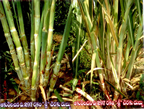 Sugarcane, being a member of the grass (Gramineae) family like rice, wheat and other cereals, has similar growth potentials that respond positively to SRI-like management: Wider spacing, younger seedlings, soil aeration, optimizing water applications, increased soil organic matter. Farmers in Andhra Pradesh and other states of India had already begun extrapolating what they were learning from their SRI experience with rice to their sugarcane crops by 2004. The photo at right shows the difference between SSI and conventionally planted sugarcane. Over the next five years much experience has accumulated, and there has been a proliferation of adaptations. However, it is important to note that there are areas of India where traditional methods of sugarcane cultivation are similar to SSI.
Sugarcane, being a member of the grass (Gramineae) family like rice, wheat and other cereals, has similar growth potentials that respond positively to SRI-like management: Wider spacing, younger seedlings, soil aeration, optimizing water applications, increased soil organic matter. Farmers in Andhra Pradesh and other states of India had already begun extrapolating what they were learning from their SRI experience with rice to their sugarcane crops by 2004. The photo at right shows the difference between SSI and conventionally planted sugarcane. Over the next five years much experience has accumulated, and there has been a proliferation of adaptations. However, it is important to note that there are areas of India where traditional methods of sugarcane cultivation are similar to SSI.
A Sustainable Sugarcane Initiative (SSI) was launched in May 2009 by the joint Dialogue Project on Food, Water and Environment established by the World Wide Fund for Nature (WWF) and the International Crop Research Institute for the Semi-Arid Tropics (ICRISAT) “to improve sugarcane cultivation in India.” The picture at right (same variety) compares sugarcane grown with normal practices and SSI (far right) in Andhra Pradesh state of India. The original manual for the Initiative reports that SSI methods can increase sugarcane yields by at least 20%, with 30% less water and a 25% reduction in chemical inputs. (Training manuals are available in English, Tamil, Oriya, and several other languages). This makes sugarcane production more profitable and environmentally friendly at a time when production costs have been rising and economic returns are declining; and when water availability is becoming a constraint and concern with adverse environmental impacts is growing. The team leader for the ICRISAT-WWF project, Dr. Biksham Gujja, noted in his introduction: “The inspiration for putting the SSI package together is from the successful approach of the System of Rice Intensification." (See item on this WWF-ICRISAT Initiative and their SSI website). Manuals updated in 2012 are available by e-mailing AgSri.
With 45 million farmers in India cultivating the sugarcane crop over 5 million hectares, Dr. Gujja decided there was work enough in India and founded the company AgSri in 2010 in Hyderabad. AgSri promotes SSI as well as selling seedlings grown from chipping off buds from sugarcane plants and growing them into seedlings in coconut pith packed into plastic trays. The farmers no longer need to hold back 10-15% of their crop as seed cane when they use SSI, and according to a 2012 article about Gujja's company, it's far cheaper to source the seedlings from AgSri because farmers can also use their farm land and labor to for other purposes. During 2012, AgSri published a book that describes farmer experiences with SSI. The publication, entitled Farmers from the field - SSI - More with less, documents farmer experiences in Andhra Pradesh, Maharashtra, Punjab, Tamil Nadu and Uttar Pradesh; farmers concluded that: a) the seed material can be significantly decreased b) wide spacing increases the production c) water savings can be substantial d) short duration intercrops will open whole new opportunities for farmers in increasing the income and improving the soil fertility.
After learning of the successes in India with adapting SRI principles for sugarcane and receiving an SSI manual from Biksham Gujja, Rena Pérez promoted SSI (SiCAS in Spanish) in Bahía Honda on the north coast of Cuba beginning in 2011. For the last few years, SSI has become more popular in India and in 2015 was introduced into Kenya and Uganda. For an overview of the benefits of SSI, see the description on the AgSRI website.
Reports and Articles
- *Manikandan, M., and G. Thiyagarajan. 2021. Study on irrigation and fertigation scheduling for Sustainable Sugarcane Initiative (SSI) through subsurface drip irrigation. Cutting-Edge Research in Agricultural Sciences 13: 55–61. doi:10.9734/bpi/cras/v13/11364D
- Manikandan, M. et al. 2019. Optimization of irrigation and fertigation scheduling for Sustainable Sugarcane Initiative (SSI) through subsurface drip irrigation in Western Zone of Tamil Nadu. Current Agriculture Research Journal 7(1). doi: http://dx.doi.org/10.12944/CARJ.7.1.14
- 2018. *Government project to boost cane production. New Indian Express, May 4. [Tamil Nadu Ag. Dept. promoting SSI to deal with changing climate conditions and to raise yields.]
- Adhikari, Prabhakar, et al. 2017. System of crop intensification for more productive, resource-conserving, climate-resilient, and sustainable agriculture: experience with diverse crops in varying agroecologies. International Journal of Agricultural Sustainability (Online first Nov. 20, 2017) 1-28.
- Gopalan, Radha. 2016. An agro-ecological way through the sugarcane problem – before we quickly resort to GM crops. The Wire, Agriculture seciton, May 12. (India)
- Prabu, M. J. 2015. Sugarcane: sowing the seeds of a successful business model. The Hindu, February 19. (Tamil Nadu, India)
- Odisha Diary bureau. 2014. Odisha: Sustainable Sugarcane Initiative boon for farmers. Odisha Diary website. January 11.
- Ganesan, S. 2013. SSI sweetens deal for sugarcane growers. The Hindu, August 22. [Ag. Dept, who says SSI can double yields from 40 to 80 tons/acre, hopes to cover 1,125 acres with SSI methods together with subsidized drip irrigation in Tamil Nadu's Tiruchi district.]
- Scott, D. J. Walter. 2013. Ramnad farmer blazes new trail. The Hindu, Tamil Nadu section, April 30. [First Ramanthapuram farmer to have a single bud chip sugarcane nursery for SSI explains how he is profitting from SSI methods]
- (Staff reporter). 2013. ‘Water saving technologies can boost farm output.’ The Hindu, April 25. [Tamil Nadu prof says that for mechanical sugarcane cultivation, following sustainable sugarcane initiative with wider row spacing and subsurface drip irrigation is important]
- Pinjarkar, Vijay. 2013. Sandrap calls for sustainable sugarcane cultivation to tackle drought. Times of India. April 23. [SSI suggested for Maharashtra in light of drought]
- G. Sathyamoorth, G. 2013. SSI doubles sugarcane output. The Hindu, March 8, [High yields from SSI and drip-irrigation in Tiruchi, Tamil Nadu, India)
- Pérez, Rena. 2013. SiCAS Sistema de Caña de Azúcar Sostenible. Presentation by Rena Pérez about the Sustainable Sugarcane Initiative in Cuba. 26 slides. (The last two slides inlcude additional explanations of the individual slides.)
- Pérez, Rena. 2012. The SSI trial in Bahia Honda, Cuba, suffers an "accident"! System of Rice Intensification website. November.
- Loganandhan, N., B. Gujja, V. V. Goud, and U. S. Natarajan. 2012. Sustainable Sugarcane Initiative (SSI): a methodology of "more with less." Sugar Tech (pp.1-5, early print). doi:10.1007/s12355-012-0180-y
- (Staff reporter). 2012. SSI technology to remove sugarcane yield barriers.The Hindu, September 7, Tamil Nadu section. [TNAU training on SSI, which could yield 250 tons/ha and have water savings of 40%]
- Pérez, Rena. 2012. Sistema de Caña de Azúcar Sostenible. System of Rice Intensification website. 12 slides. [pdf of a PowerPoint presentation about the "Sustainable Sugarcane System (Sistema de Caña de Azúcar Sostenible, or SiCAS in Spanish)]
- Correya, Michael. 2012. The Perfect Harvest. Business Outlook, September 1. [Story about AgSRI's work with the Sustainable Sugarcane Initiative (SSI)]
- Gujja, Biksham et al. 2012. Farmers from the field - SSI - More with less. AgSRI website. March. (60p. pdf) (7p. pdf) [Published AgSRI with assistance from NRMC (NABARD), this Sustainable Sugarcane Initiative publication was compiled with inputs/experiences of thousands of SSI farmers from different states of India]
- Gujja, Biksham, Vinod Goud, U.S. Natarajan, T.V.V.V. Rao, Suhasini Ramayanam and Sraban Dalai. 2012. Sustainable Sugarcane Initiative. AgSRI website.(7p. pdf) [Manual for Sustainable Sugarcane Initiative (SSI) methods compiled by the AgSRI Group. For the complete 48 p. manual contact AgSRI]
- Pérez, Rena. 2012. El comienzo del Sostenible Sugarcane Iniciative en Cuba. System of Rice Intensification website. (2p., 86KB pdf) [Spanish language document about the first efforts to introduce Sustainable Sugarcane Initiative (SSI) to Cuba].
- Pérez, Rena. 2012. A second visit to the Sustainable Sugarcane Initiative in Bahía Honda, Cuba. System of Rice Intensification website. January 27.
- Pérez, Rena. 2011.The Sustainable Sugarcane Initiative "internets" its way to Cuba. AgSRI website.
- 2011. The Sustainable Sugarcane Initiative in Orissa - NIRMAN, 2/10/2011. System of Rice Intensification website.
- 2012. State to adopt innovative sugarcane cultivation. The Hindu, April 14, Other States section.
- 2010. Orissa NGO NIRMAN releases training manual on Sustainable Sugarcane Initiative (SSI). Orissa Diary website. April 13. (6p., 255KB pdf)
Practical Information
- Gujja, Biksham, Vinod Goud, U.S Natarajan, T. V. V. V Rao, Suhasini Ramayanam and Sraban Kumar Dalai. 2012. SiCAS - Sistema de Caña de Azúcar Sostenible - Produciendo 'Más con Menos'. AgSRI website. (Spanish translation by Rena Pérez; 50p. pdf) [System of Rice Intensification principles as adapted to sugarcane by Biksham Gujja. English version is directly below.]
- Gujja, Biksham, Vinod Goud, U.S. Natarajan, T.V.V.V. Rao, Suhasini Ramayanam and Sraban Dalai. 2012. Sustainable Sugarcane Initiative. AgSRI website.(7p. pdf) [Manual for Sustainable Sugarcane Initiative (SSI) methods compiled by the AgSRI Group. For the
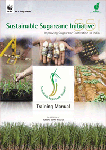 complete 48 p.manual contact AgSRI]
complete 48 p.manual contact AgSRI] -
The original manual for the Initiative (at right) reports that SSI methods can increase sugarcane yields by at least 20%, with 30% less water and a 25% reduction in chemical inputs. (The training manuals are available in English, Tamil, Oriya, and several other languages).
Videos and PowerPoints
- Video: 2019 (July 27). இந்த முறையில் கரும்பு நடவு செய்தால் அதிக லாபம் SSI System. Ulavan Tech Channel, YouTube. 7:09 min. [English/Tamil Nadu, India; Sustainable Sugarcane Initiative instructional video with input from GIZ, TNAU, KVK Santhiur, and students - AC & RI, VVNR]
- Video: 2017 (May 4). S. S. I. cultivation cultivation in sugar cane. 17:14 min. pasumai vivashayam channel, YouTube. [Tamil language video on the Sustainable Sugarcane Initiative, based on SRI principles.]
- Video: 2016 (April 22). Sustainable Sugarcane Initiative (SSI). 19:06 min. Produced by Tamil Nadu Agricultural University. raja mani channel, YouTube.
- Video: 2015 (June 16). Western Kenya Sugar Company set to introduce a new variety of sugarcane. 2:18 min. KTN News Kenya, YouTube [KTN TV News clip about a Kenyan company possibly adopting SSI.]
- Video: 2013 (July 9). Sustainable Sugarcane Initiative. 10:19 min. Produced by TNAU Agritech Portal. TNAU Agritech Portal channel, YouTube.
- PowerPoint: Gujja, Biksham. 2013. "More with Less" - The Sustainable Sugarcane Initiative (SSI) in India and Beyond: Experience & Future Directions. Presentation at SRI-Rice Center, Cornell Unversity, Ithaca, NY. February 8. 40 slides.
- PowerPoint (poster): V. Shashi Bhushan, Norman Uphofff, K. Suresh and M. Sudarshan Reddy. 2008. Sugarcane Intensification System: An Innovative Method. 2008. Poster presented at the 2008 SRI National Symposium, Tamil Nadu Agricultural University, Coimbatore, India. (also available in pdf version.)
- Videos: The SRI-Rice Playlist of Sustainable Sugarcane Initiative (SSI) videos on YouTube is now available (7 videos in 4 languages).
- Video: 2012 (October 12). CBD COP11: Small changes to big sectors can have a huge impact. RTCC channel, Vimio.[In an interview at the Oct. 2012 Convention on Biodiversity in Hyderabad, India, Gujja describes the work of his organisation, AgSri, in reducing water use in Indian agriculture.]
Progress Reports (India)
-
One of the first farmer-innovators with sugarcane was Prabhakar Reddy, whose work was assisted and reported by Dr. Shashi Bhushan at Medak district agricultural research station of the state’s agricultural university, ANGRAU. In 2005, Reddy and Bhushan reported to Uphoff that Reddy in his first year, with an alternative management system, reached a yield of 100 t/ha. This was triple his previous yield, achieved with a 90% reduction in planting material (setts) and with 40% less water, changes similar to those seen with SRI. (See excerpt from Uphoff 2005 trip report). Reddy thought that the next year he could reach 120 t/ha with these method: “Now that I know what I am doing.” However, according to Bhusan, Reddy’s yield in 2006 was only 110 tons/hectare, very respectable.
The methodology that Reddy initiated was reported by Bhushan in a poster presented at the National SRI Symposium held in 2008 at Tamil Nadu Agricultural University. This reported that yields with alternative methods had reached 125 t/ha and even more, with individual canes weighing 2.5-3 kg each instead of the more usual 1 kg weight. The Financial Express reported in 2006 that the Andhra Pradesh government was going to support Sugar Cane Intensification (SCI) experiments on 3,000 acres.
A cutting tool has been devised for removing buds from the cane, to be grown into budlings for transplanting with wide spacing instead of planting setts, and it considerably improves the efficiency of crop establishment. It also saves all cane for sugar production, rather than having some used to start a new crop. Dr. A. Satyanarayana, previously ANGRAU director of extension, has provided a series of pictures below on these semi-mechanized methods that are gaining popularity in AP state. (Click on the photos below to enlarge).



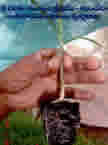

Separating buds Planting buds in plastic trays Budlings growing in the nursery Budling ready to plant Transporting budlings to the fields As mentioned above, the Andhra Pradesh-based company AgSri began promoting SSI in 2010, and has produced a new manual and farmer stories about the use of SSI.
-
Madhya Pradesh:
A labor-saving cutting tool developed for removing buds to start sugarcane ‘budlings’ has been reported from this state in a 2009 article in The Hindu
-
Orissa:
In a 2011 report on SSI in the Nayagarh District in Eastern Orissa, the NGO NIRMAN finds the reduction in production costs with SSI is especially beneficial to debt-bound farmers. NIRMAN estimate that by adopting SSI methods, farmers will be able to produce at least 60% more sugarcane while reducing their water inputs by 3 times (or more). With SSI, only 5,000 seedlings are required, weighing only 25-30 kg instead of the 5-6 tons of sugarcane required with conventional methods. Moreover, farmers can crush the cane from which the buds were removed after these are removed with a bud chipper. Making jaggery from the juice is an added economic benefit of SSI.
With conventional methods, farmers reported during 2010 that they must spend up to Rs. 16,000/- (nearly $ 350) just for planting material. As with SRI, when SSI is adopted, there is about a 90% reduction in seed costs. So, with lower expenditure, farmers can get more yield and use less water at the same time. NIRMAN's report notes that "there is irregular/deficient rainfall in the Nayagarh district and as sugarcane is the thirstiest crop after paddy, SSI is a good solution to deal with the water-scarcity problems mentioned above since water is a growing constraint for sugarcane production. The savings in labor are also a major benefit for farmers. Reducing costs by two-thirds is an unprecedented attraction".
According to an article in The Hindu (April 14, 2010), the Orissa State government has decided to take up Sustainable Sugarcane Initiative. State Agriculture Minister Damodar Rout said he would ask scientists of Orissa University of Agriculture Technology (OUAT) to analyze the feasibility aspect of SSI and that OUAT would popularize SSI among farmers through its extension programme on sugar cultivation. The SSI was introduced in Nayagarh district where 20 farmers showed interest in planting SSI method of sugarcane cultivation in four acres of demonstration plot in 2009 (see also SVA letter about farmers using what they learned from counterparts in Maharashtra state.)
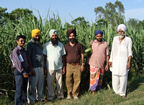
-
Haryana:
A farmer-devised method for inducing in-plant germination is reported to raise survival rates of sugarcane seedlings (see Beni Singh method).
Andhra Pradesh
Punjab:
SSI methods are also being introduced in this state. The Punjab Department of Agriculture initially nominated 4 farmers for SSI training in January 2009 that was organized by ICRISAT at Pattanchur, Hyderabad, under the ATMA program. After this training, DOA organized demonstrations in the field by these trained farmers in District Gurdaspur, under the auspices of ATMA. Initial farmer response has been positive, as there is 95% reduction in planting material, saving both money and area otherwise devoted to crop establishment. Farmers report more and larger millable canes, as reported by Dr. Amrik Singh, shown with colleagues in photo at right. (see Singh's report).
Tamil Nadu:
A May 4, 2018, article in the New Indian Express, reports that, with the unpredictable climatic conditions, particularly erratic monsoon, hitting the agricultural production in Tamil Nadu at times, the agriculture department is putting thrust on propagation of high-yielding sugarcane varieties through a project, Sustainable Sugarcane Initiative (SSI), aimed at making the ryots reap rich with minimum efforts and investments. The project has come as a boon to farmers because it leads to increase in production and improve sugar recovery. Certain sugarcane varieties developed by the Sugarcane Breeding Institute at Coimbatore (o 2012, CoC-25, Co 09004 and Clone 29442) are being provided to the farmers for SSI. The department would procure bud chip seedlings and tissue culture plants from the Sugarcane Breeding Institute and distribute them to the farming community. Farmers can realize an yield of 125 tons per hectare under the SSI method of cultivation against 100 tonnes through the conventional method. In trial plots, these varieties have registered a higher yield ranging from 20 to 35 tonnes per hectare than the conventional field. The government provides the farmers with a financial assistance of `9,000 per hectare if they switch over to the SSI method of cane growing, besides offering them technological support and supply of high quality bud chips. For 2017-18, the government allocated funds close to ` 30 crore. The main advantages of adopting cultivation methods under SSI are judicious use of water for irrigating the crop, better moisture level, less number of seeds and availability of space for inter-cropping.
SSI-INDIA Network
The ICRISAT-WWF Project is supporting an SSI network in India that parallels the SRI-India network. More information about the network is available on the discussion group site (http://groups.google.co.in/group/SSI-India) and on the WWF ICRISAT sugarcane website. The first issue of the network newsletter, Sugarcane Matters, was published in November 2009 through the discussion group site.
Dr. Biksham Gujja reported a very quick and positive response to the ICRISAT-WWF initiative in India, facilitated by the economic competitiveness of the industry, growing water constraints, rising costs of production, and larger size of sugarcane growing operations. Anyone interested is encouraged to follow the SSI-India website noted above, and to subscribe to the SSI Newsletter, Sugarcane Matters, and participate in the SSI-India discussion group noted above. Dr. Gujja has also AgSRI, a company that supports the spread of SSI and other sustainable crop intensification applications based on the principles of SRI.
Progress Reports (Cuba)
After learning of the successes in India with adapting SRI principles for sugarcane and receiving an SSI manual from Biksham Gujja, Rena Pérez promoted SSI (SiCAS in Spanish) in Bahía Honda on the north coast of Cuba beginning in 2011 (see article). The managers at the "Camilo Cienfuegos" cane coop were enthusiastic about the tillering and growth as well as the reduction in cane needed to plant the fields. The traditional method requires 13 tons/ha of clean cane while the SSI method uses only 2 tons/ha! (see updates: article and Spanish language presentation)
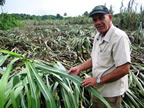
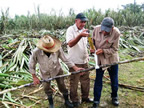 The SiCAS trials undertaken on 0.9 hectare at the Bahía Honda sugarcane coop, however, were unfortunately burned prematurely in November 2012- about two months prior to when they should have been harvested. Raul Frontera, one of the coop's technicians, decided to count and measure the width of the upper leaves (left) of several cane stalks. He relayed that while normal cane has seven leaves, those in the burned SiCAS field had eleven leaves and were eight centimeters wide. Furthermore, while normal cane grown there had 12 and 13 tillers, the cane in the burned field had between 18 and 20 (right). The technician responsible for the SiCAS plot subsequently estimated that the cane harvested from the destroyed field translated to about 150 - 160 tons/ha. While the SiCAS was originally of interest to prepare replacements for transplanting in conventional fields, these results may persuade the coop to adopt SiCAS on full fields. (See report for details).
The SiCAS trials undertaken on 0.9 hectare at the Bahía Honda sugarcane coop, however, were unfortunately burned prematurely in November 2012- about two months prior to when they should have been harvested. Raul Frontera, one of the coop's technicians, decided to count and measure the width of the upper leaves (left) of several cane stalks. He relayed that while normal cane has seven leaves, those in the burned SiCAS field had eleven leaves and were eight centimeters wide. Furthermore, while normal cane grown there had 12 and 13 tillers, the cane in the burned field had between 18 and 20 (right). The technician responsible for the SiCAS plot subsequently estimated that the cane harvested from the destroyed field translated to about 150 - 160 tons/ha. While the SiCAS was originally of interest to prepare replacements for transplanting in conventional fields, these results may persuade the coop to adopt SiCAS on full fields. (See report for details).
On December 15, 2012, Rena Pérez made a presentation in Matanzas, Cuba, to a group of approximately 90 professionals working in the island's sugar industry. The talk, which focused on SRI adaptations to sugarcane (SSI, or SiCAS in Spanish) and generated considerable interest among the audience members, reflected preliminary results of the first trial on the Sustainable Sugarcane Initiative (SSI) in the "Camilo Cienfuegos" cane coop in Bahia Honda, Artemisa, Cuba. Pérez also orchestrated the translation into Spanish of AgSRI's Sustainable Sugarcane Initiative publication about SiCAS (SSI) in India. The publication, SiCAS Sistema de Caña de Azúcar Sostenible is available on the AgSRI website.

